|
(terms in parenthesis describe attitudinally correct terms for describing the
human heart.)
Human
The human heart can appear as a variety of shapes including elliptical,
conical, round, valentine and trapezoidal (1). Within the thoracic cavity, the
human heart exhibits greater left-side orientation, the apex is more tilted
towards the left side of the body, compared to those of most quadruped mammals
(3). The apex may be formed entirely by the myocardium of the left ventricle or
by both the right and left ventricles (1). The average weight ratio of the human
heart to the rest of the body is 5 g/kg (4). Compared to the hearts of swine,
canine and ovine, the posterior (posteroinferior) base to apex distance, the
left lateral base to apex distance and the length of the coronary sinus are all
significantly greater in the human heart (1). Likewise, the right lateral base
to apex distance of the human heart is significantly longer compared to porcine
and canine but is similar in length to that of the ovine heart. The anterior
(anterosuperior) base to apex distance is comparable in length to that of swine,
ovine and canine hearts (handbook).
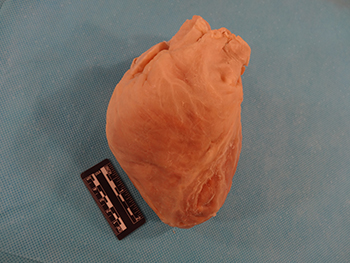
An anterosuperior view of a plastinated human heart. The human heart can have a number of shapes including elliptical, conical, round, valentine or trapezoidal (1). This particular heart is trapezoidal in shape.
|
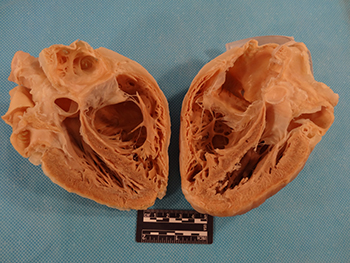
A plastinated human heart cut coronally to form an anterosuperior half (left) and a posteroinferior half (right). The apex of the human heart may be formed entirely by the left ventricle or it may be a “joint apex”, formed by both the left and right ventricle (1). This particular heart has a joint apex.
|
This heart was donated for research from a 44 year old female with a history of Atherosclerotic heart disease and a myocardial infarction.
|
Canine
Canine hearts are generally ovoid in shape (1). The apex of the canine
heart appears blunter than in ovine, porcine, or human hearts and is formed
entirely by the left ventricle. Like most quadruped mammals, the canine heart is
more medially located and the apex is more ventrally tilted compared to humans
(3). The ratio of heart weight to body weight is 6.95 g/kg though this value may
be breed dependent (5, 6). The posterior (posteroinferior) base to apex
distance, the right and left lateral base to apex distances and the length of
the coronary sinus are all significantly shorter than in humans but are similar
in length to ovine and porcine hearts (1). The anterior (anterosuperior) base to
apex distance is similar to humans and swine but is significantly shorter
compared to ovine hearts (1).
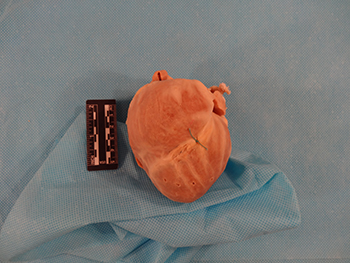
An anterior view of a plastinated canine heart. The apex of the canine heart is much blunter than that of humans, swine or ovine (1). The canine heart tends to be ovoid in shape (1).
|
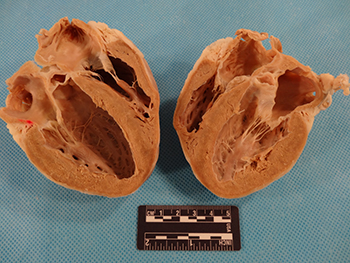
A plastinated canine heart cut coronally to form a posterior half (right) and an anterior half (left). The apex of the canine heart is formed entirely by the left ventricle (1).
|
A plastinated canine heart 3D scan.
|
Ovine
The ovine heart varies in shape from conical to valentine (1). The apex is
formed entirely by the left ventricle and is more pointed than human, canine or
porcine hearts. Like most quadruped mammals, the heart is positioned more
medially and the apex is more ventrally tilted than in humans (3).The ratio of
heart weight to body weight is 3.13 g/kg but may vary between breeds (5, 6). The
posterior (posteroinferior) base to apex distance, the right and left lateral
base to apex distances and the external length of the coronary sinus are all
significantly shorter than in humans (1). The anterior (anterosuperior) base to
apex distance is similar to human and porcine hearts but significantly longer
compared to canine hearts. The posterior (posteroinferior) base to apex distance
and the external length of the coronary sinus are similar in length compared to
porcine and canine hearts (1). The right lateral base to apex distance is
significantly longer compared to the porcine heart but is comparable to canine
hearts (1).
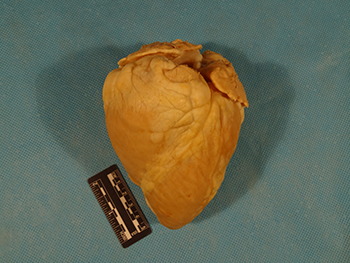
An anterior view of a plastinated ovine heart. The ovine heart has a much more pointed apex than humans, swine or canine (1). The ovine heart may be conical or valentine shaped (1). This particular heart is conical in shape.
|
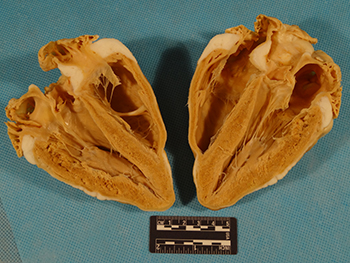
A plastinated ovine heart cut coronally to form a posterior half (right) and anterior half (left). The apex of the ovine heart is formed entirely by the left ventricle (1).
|
A plastinated ovine heart 3D scan.
|
Porcine
The porcine heart tends to be valentine shaped (1). The apex is formed
entirely by the left ventricle and is blunter than the ovine heart though not as
rounded as the canine heart. Like most quadruped mammals, the heart is
positioned more medially and is tilted more ventrally compared to human hearts
(3).The ratio of heart weight to body weight is 2.89 g/kg but may be breed
specific (5, 6). The anterior (anterosuperior) base to apex distance of the
porcine heart is similar to humans, canine and ovine hearts. The posterior
(posteroinferior) base to apex distance, the right lateral base to apex
distance, the left lateral base to apex distance and the length of the coronary
sinus are all significantly smaller than in humans but are comparable to those
of canine hearts (handbook). These measurements are also similar to those of
ovine hearts aside from the right lateral base to apex distance which is
significantly shorter in swine compared to sheep.
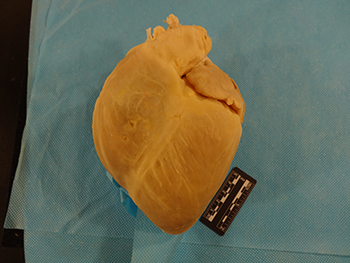
An anterior view of a plastinated porcine heart. The hearts of swine tend to be valentine shaped (1).
|
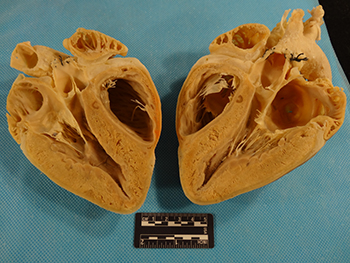
A plastinated porcine heart cut coronally to form a posterior half (right) and anterior half (left). The apex of the porcine heart is formed entirely by the left ventricle (1).
|
A plastinated porcine heart 3D scan.
|
|


